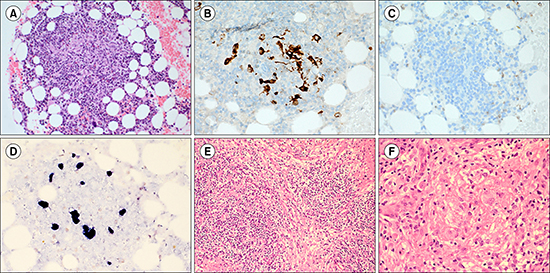
A 73-year-old man with no past medical history transferred to Asan Medical Cener after being diagnosed with hydrocephalus resulted from recent dementia and falling down. Splenomegaly and multiple enlarged lymph nodes was found on computed tomography. His hemoglobin level was 8.6 g/dL; platelet count, 65×109/L; white blood cell count, 3.9×109/L; and mean corpuscular volume, 96.4 fL. A bone marrow (BM) aspirate revealed trilineage hematopoietic components with reactive plasmacytosis (plasma cells: 4.8% among BM nucleated cells). BM biopsy and clot section showed a normocellular marrow (40% cellularity) with multiple fibronodular and granulomatous lesions (A; BM clot section, H&E stain, ×200). Neoplastic cells on the granulomatous lesions were positive for CD30 (B; BM clot section, Immunohistochemical stain for CD30, ×400), negative for CD15 (C; BM clot section, Immunohistochemical stain for CD15, ×400) and CD20, and positive for Epstein-Barr virus (EBV)-encoded RNA in situ hybridization (D; BM clot section, EBV in situ hybridization, ×400). The lymph node biopsy on the neck was diagnosed with classical Hodgkin lymphoma (HL), nodular sclerosis type (E and F; Lymph node, H&E stain, ×200 and ×400, respectively).
In a retrospective analysis based on patients with HL, CD15 negative patients had a higher incidence of relapse and a lower survival rate. But the other analysis failed to observe the prognostic role of CD15. The pathobiology of HL has been elucidated. EBV may play a role in the pathobiology of a significant fraction of HL cases.




 PDF
PDF ePub
ePub Citation
Citation Print
Print


 XML Download
XML Download